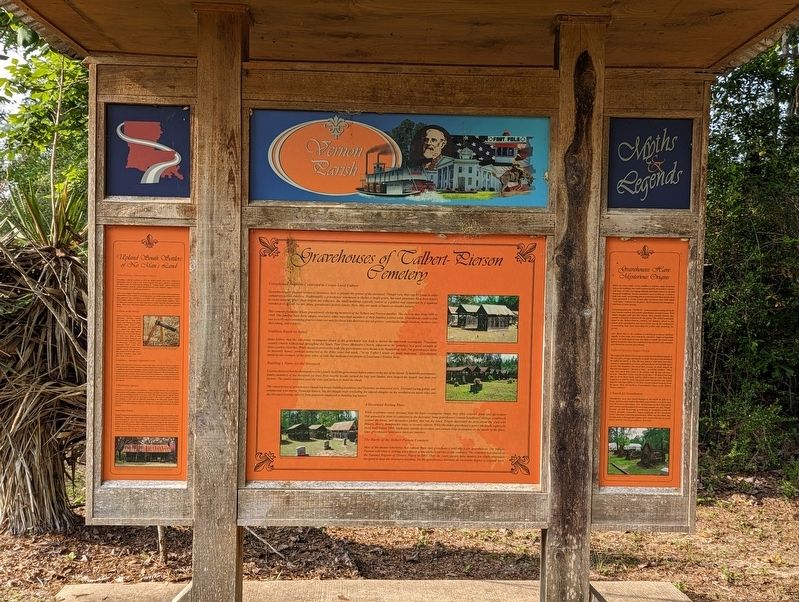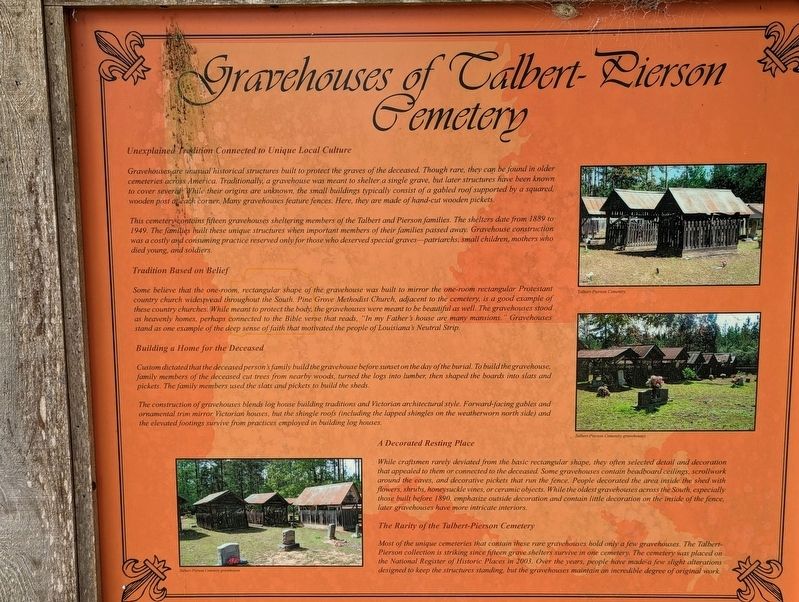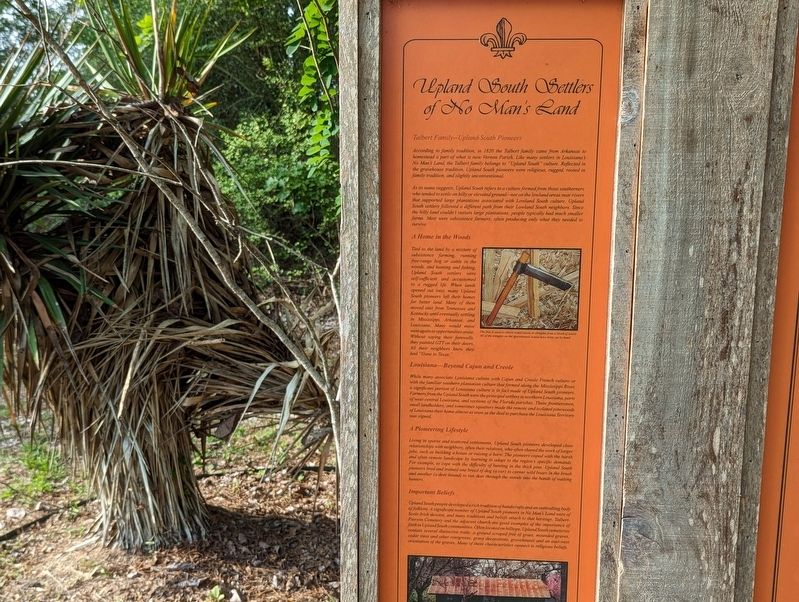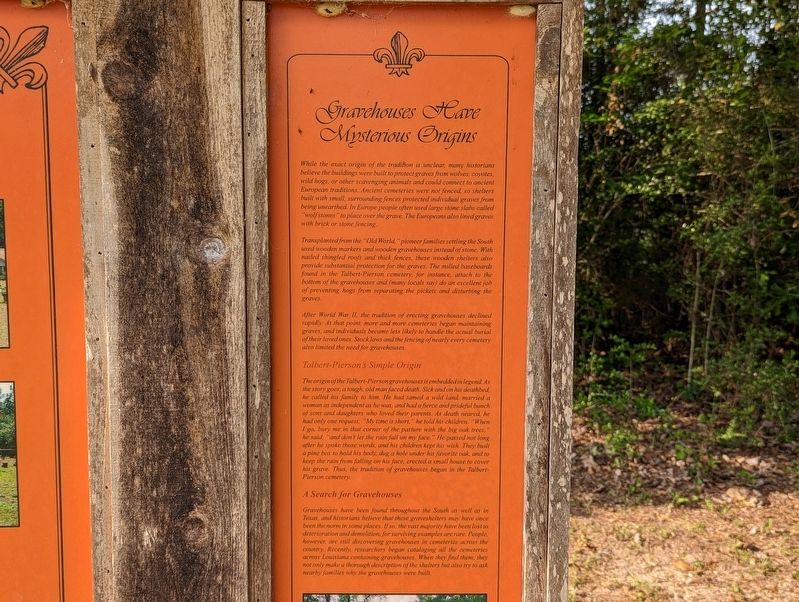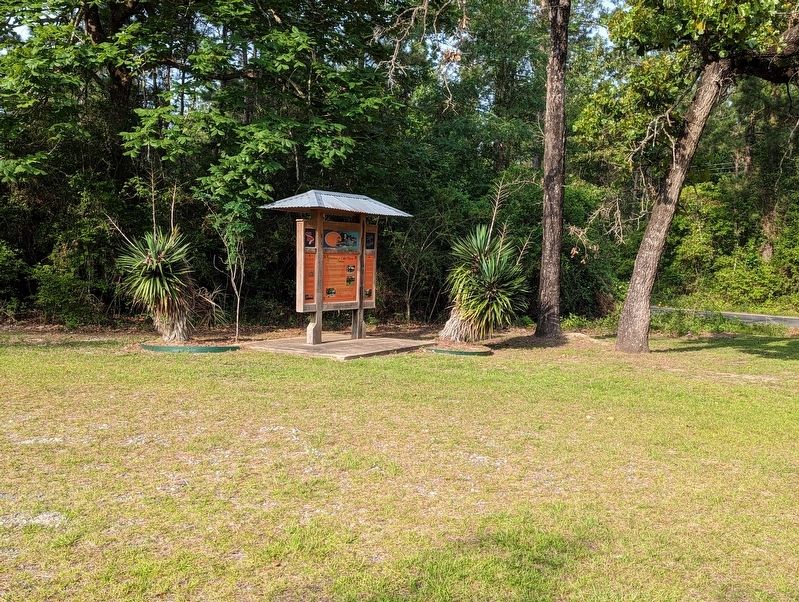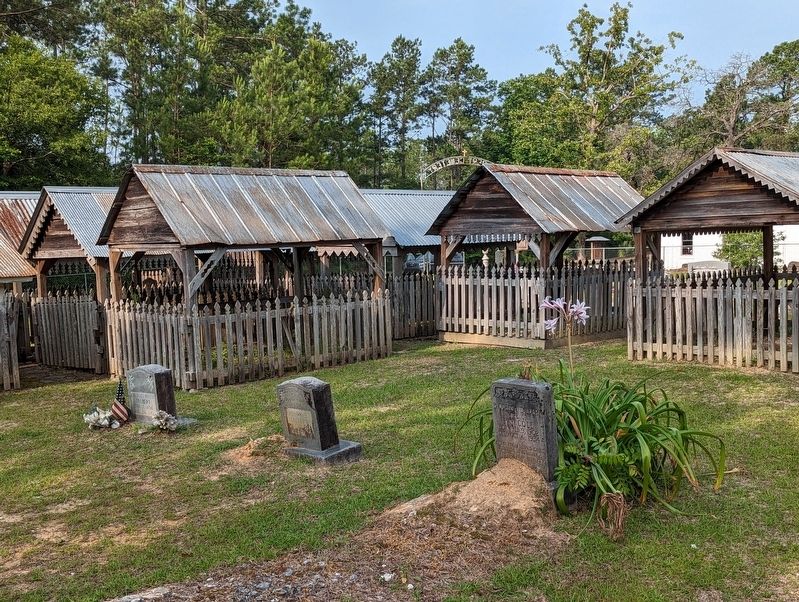Sugartown in Vernon Parish, Louisiana — The American South (West South Central)
Gravehouses of Talbert-Pierson Cemetery
Louisiana Myths and Legends Byway
— Vernon Parish —
Unexplained Tradition Connected to Unique Local Culture
Gravehouses are unusual historical structures built to protect the graves of the deceased. Though rare, they can be found in older cemeteries across America. Traditionally, a gravehouse was meant to shelter a single grave, but later structures have been known to cover several While their origins are unknown, the small buildings typically consist of a gabled roof supported by a squared, wooden post aleach corner. Many gravehouses feature fences. Here, they are made of hand-cut wooden pickets.
This cemetery contains fifteen gravehouses sheltering members of the Talbert and Pierson families. The shelters date from 1889 to 1949. The families built these unique structures when important members of their families passed away. Gravehouse construction was a costly and consuming practice reserved only for those who deserved special graves-patriarchs, small children, mothers who died young, and soldiers.
Tradition Based on Belief
Some believe that the one-room, rectangular shape of the gravehouse was built to mirror the one-room rectangular Protestant country church widespread throughout the South. Pine Grove Methodist Church, adjacent to the cemetery, is a good example of these country churches. While meant to protect the body, the gravehouses were meant to be beautiful as well. The gravehouses stood as heavenly homes, perhaps connected to the Bible verse that reads, "In my Father's house are many mansions." Gravehouses stand as one example of the deep sense of faith that motivated the people of Louisiana's Neutral Strip.
Building a Home for the Deceased
Custom dictated that the deceased person's family build the gravehouse before sunset on the day of the burial. To build the gravehouse, family members of the deceased cut trees from nearby woods, turned the logs into lumber, then shaped the boards into slats and pickets. The family members used the slats and pickets to build the sheds.
The construction of gravehouses blends log house building traditions and Victorian architectural style. Forward-facing gables and ornamental trim mirror Victorian houses, but the shingle roofs (including the lapped shingles on the weatherworn north side) and the elevated footings survive from practices employed in building log houses.
A Decorated Resting Place
While craftsmen rarely deviated from the basic rectangular shape, they often selected detail and decoration that appealed to them or connected to the deceased. Some gravehouses contain beadboard ceilings, scrollwork around the eaves,
and decorative pickets that run the fence. People decorated the area inside the shed with
flowers, shrubs, honeysuckle vines, or ceramic objects. While the oldest gravehouses across the South, especially
those built before 1890, emphasize outside decoration and contain little decoration on the inside of the fence,
later gravehouses have more intricate interiors.
The Rarity of the Talbert-Pierson Cemetery
Most of the unique cemeteries that contain these rare gravehouses hold only a few gravehouses. The Talbert- Pierson collection is striking since fifteen grave shelters survive in one cemetery. The cemetery was placed on the National Register of Historic Places in 2003. Over the years, people have made a few slight alterations designed to keep the structures standing, but the gravehouses maintain an incredible degree of original work.
Upland South Settlers of No Man's Land
Talbert Family--Upland South Pioneers
According to family tradition, in 1820 the Talbert family came from Arkansas to homestead a part of what is now Vernon Parish. Like many settlers in Louisiana's No Man's Land, the Talbert family belongs to "Upland South" culture. Reflected in the gravehouse tradition, Upland South pioneers were religious, rugged, rooted in family tradition, and slightly
unconventional.
As its name suggests, Upland South refers to a culture formed from those southerners who tended to settle on hilly or elevated ground-not on the lowland areas near rivers that supported large plantations associated with Lowland South culture. Upland South settlers followed a different path from their Lowland South neighbors. Since the hilly land couldn't sustain large plantations, people typically had much smaller farms. Most were subsistence farmers, often producing only what they needed to survive.
A Home in the Woods
Tied to the land by a mixture of subsistence farming, running free-range hog or cattle in the woods, and hunting and fishing, Upland South settlers self-sufficient and accustomed to a rugged life. When lands opened out west, many Upland South pioneers left their homes for better land. Many of them moved east from Tennessee and Kentucky until eventually settling in Mississippi, Arkansas, and Louisiana. Many would move west again as opportunities arose. Without saying their farewells, they painted GTT on their doors. All their neighbors knew they had "Gone to Texas.
Louisiana-Beyond Cajun and Creole
While many associate Louisiana culture with Cajun and Creole French culture or with the familiar southern plantation culture that formed along the Mississippi
River,
a significant portion of Louisiana culture is in fact made of Upland South pioneers.
Farmers from the Upland South were the principal settlers in northern Louisiana, parts
of west-central Louisiana, and sections of the Florida parishes. These frontiersmen,
small landholders, and sometimes squatters made the remote and isolated pinewoods
of Louisiana their home almost as soon as the deal to purchase the Louisiana Territory
was signed.
A Pioneering Lifestyle
Living in sparse and scattered settlements, Upland South pioneers developed close relationships with neighbors, often their relatives, who often shared the work of larger jobs, such as building a house or raising a barn. The pioneers coped with the harsh and often remote landscape by learning to adapt to the region's specific demands. For example, to cope with the difficulty of hunting in the thick pine, Upland South pioneers bred and trained one breed of dog (a cur) to corner wild boars in the brush and another (a deer hound) to run deer through the woods into the hands of waiting hunters.
Important Beliefs
Upland South people developed a rich tradition of handicrafts and an enthralling body of folklore. A significant number of Upland South pioneers in No Man's Land were of Scots-Irish descent, and many traditions and beliefs attach to that heritage. Talbert- Pierson Cemetery and the adjacent church are good examples of the importance of faith in Upland South communities. Often located on hilltops, Upland South cemeteries contain several distinctive traits: a ground scraped free of grass, mounded graves, cedar trees and other evergreens, grave decorations, gravehouses and an east-west orientation of the graves. Many of these characteristics connect to religious beliefs.
Gravehouses Have Mysterious Origins
While the exact origin of the tradition is unclear, many historians believe the buildings were built to protect graves from wolves, coyotes, wild hogs, or other scavenging animals and could connect to ancient European traditions. Ancient cemeteries were not fenced, so shelters built with small, surrounding fences protected individual graves from being unearthed. In Europe people often used large stone slabs called "wolf stones" to place over the grave. The Europeans also lined graves with brick or stone fencing.
Transplanted from the "Old World," pioneer families settling the South used wooden markers and wooden gravehouses instead of stone. With nailed shingled roofs and thick fences, these wooden shelters also provide substantial protection for the graves. The milled baseboards found in the Talbert-Pierson cemetery, for instance, attach
to the
bottom of the gravehouses and (many locals say) do an excellent job
of preventing hogs from separating the pickets and disturbing the
graves.
After World War II, the tradition of erecting gravehouses declined rapidly. At that point, more and more cemeteries began maintaining graves, and individuals became less likely to handle the actual burial of their loved ones. Stock laws and the fencing of nearly every cemetery also limited the need for gravehouses.
Talbert-Pierson's Simple Origin
The origin of the Talbert-Pierson gravehouses is embedded in legend. As the story goes, a tough, old man faced death. Sick and on his deathbed, he called his family to him. He had tamed a wild land, married a woman as independent as he was, and had a fierce and prideful bunch of sons and daughters who loved their parents. As death neared, he had only one request: "My time is short," he told his children. "When I go, bury me in that corner of the pasture with the big oak trees, he said, "and don't let the rain fall on my face." He passed not long after he spoke those words, and his children kept his wish. They built a pine box to hold his body, dug a hole under his favorite oak, and to keep the rain from falling on his face, erected a small house to cover his grave. Thus, the tradition of gravehouses began in the Talbert- Pierson cemetery.
A Search for Gravehouses
Gravehouses have been found throughout the South as well as in Texas, and historians believe that these graveshelters may have once been the norm in some places. If so, the vast majority have been lost to deterioration and demolition, for surviving examples are rare. People, however, are still discovering gravehouses in cemeteries across the country. Recently, researchers began cataloging all the cemeteries across Louisiana containing gravehouses. When they find them, they not only make a thorough description of the shelters but also try to ask nearby families why the gravehouses were built.
Erected by State of Louisiana Office of Tourism. (Marker Number 7.)
Topics and series. This historical marker is listed in this topic list: Cemeteries & Burial Sites. In addition, it is included in the Louisiana Myths & Legends Byway series list.
Location. 30° 53.393′ N, 93° 3.058′ W. Marker is in Sugartown, Louisiana, in Vernon Parish. Marker is on Victor Martin Road, 3 miles north of Louisiana Highway 112, on the right when traveling north. Touch for map. Marker is at or near this postal address: 700-914 Victor Martin Rd, Pitkin LA 70656, United States of America. Touch for directions.
Other nearby markers. At least 8 other markers are within 10 miles of this marker, measured as the crow flies. Talbert-Pierson Cemetery (within shouting distance of this marker); Sugartown (approx. 4.1 miles away); Old Camp Ground Cemetery (approx. 5˝ miles away); Old Campground (approx. 5˝ miles away); Life in a Logging Camp (approx. 6˝ miles away); Fullerton (approx. 6.6 miles away); Religion in the Neutral Strip (approx. 7˝ miles away); Fullerton Pavilion (approx. 9.2 miles away). Touch for a list and map of all markers in Sugartown.
Related marker. Click here for another marker that is related to this marker.
Credits. This page was last revised on June 10, 2023. It was originally submitted on June 10, 2023, by Cajun Scrambler of Assumption, Louisiana. This page has been viewed 107 times since then and 29 times this year. Photos: 1, 2, 3, 4, 5, 6. submitted on June 10, 2023, by Cajun Scrambler of Assumption, Louisiana.
